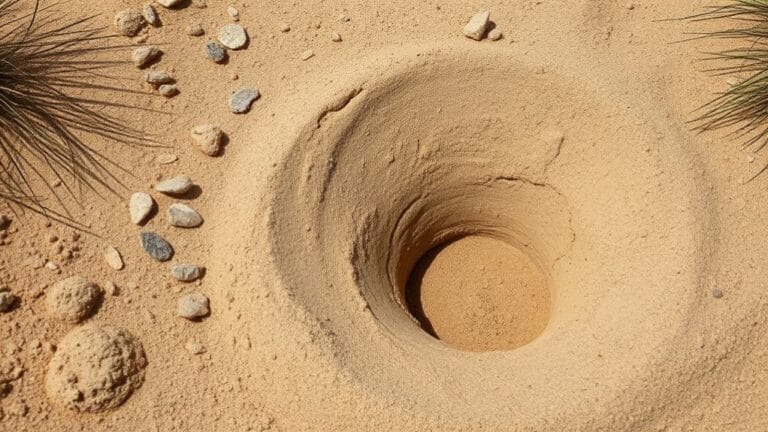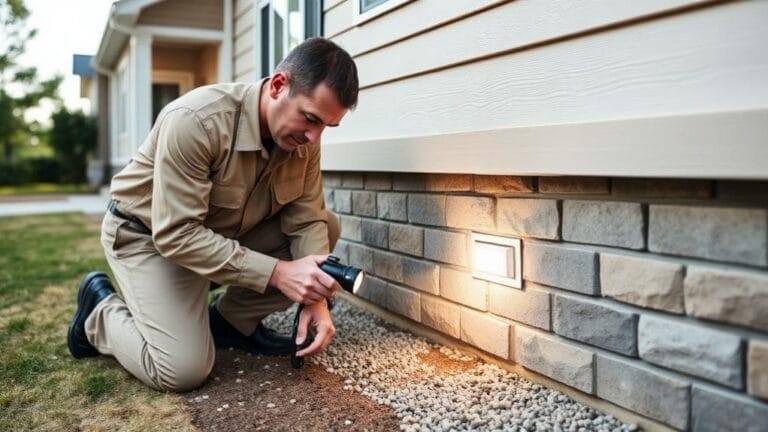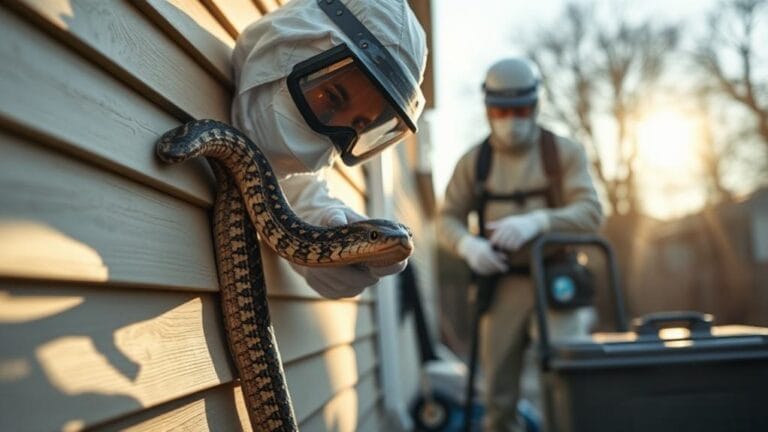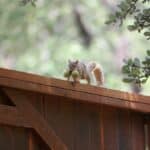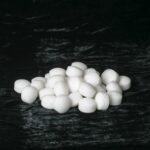Have you ever wondered what snakes do during the winter? Well, get ready to uncover the truth!
Unlike mammals, snakes don’t hibernate in the traditional sense. Instead, they enter a state called brumation. From September to March or April, snakes seek shelter in holes, caves, and even car engines to survive the chilly weather.
But don’t be fooled, they do wake up during warm snaps to search for food and water.
In this article, we’ll explore how to coexist with snakes in winter and create a harmonious environment for both humans and snakes. Let’s dive in and uncover the secrets of snakes in winter!
Key Takeaways
Table of Contents
- Snakes enter a state called brumation during the winter months.
- Snakes seek shelter in various locations such as holes, caves, logs, and buildings.
- Minimizing tall grass and overgrown landscaping helps reduce rodent populations, which in turn keeps snakes away.
- Proper storage practices, such as keeping wood piles elevated and in sealed containers, can prevent snakes from finding shelter.
Understanding Snake Brumation
During snake brumation, you may observe a decrease in snake activity as they enter a state similar to hibernation.
Snake brumation patterns are influenced by the effects of winter weather on snake metabolism. As temperatures drop, snakes seek shelter in various locations such as holes, caves, logs, rocks, basements, crawlspaces, garages, barns, sheds, wood piles, and even car engines.
They enter a state of low metabolic activity, conserving energy to survive the winter. This reduction in metabolic rate allows snakes to endure long periods without food or water.
However, snakes may occasionally wake up during warm snaps in the winter to forage for food and water.
Understanding snake brumation is crucial for managing snake populations and ensuring their survival during the winter months.
Snakes’ Winter Sheltering Habits
During the winter, snakes exhibit specific sheltering habits to survive the cold temperatures. They seek refuge in various locations such as:
- Holes
- Caves
- Logs
- Rocks
- Basements
- Crawlspaces
- Garages
- Barns
- Sheds
- Wood piles
- Even car engines
These sheltering spots provide protection from the harsh weather conditions and help snakes conserve energy until warmer periods when they emerge to search for food and water.
Winter Sheltering Locations
Snakes seek shelter in various locations during the winter, such as holes, caves, logs, rocks, basements, crawlspaces, garages, barns, sheds, wood piles, and even car engines.
These locations provide snakes with insulation from the cold temperatures, protecting them during their winter hibernation period, known as brumation.
Snakes enter a state of dormancy, slowing down their metabolism and conserving energy until the warmer months. Signs of snake presence in winter can include shed skin, tracks, and sightings near their sheltering areas.
It is important to be aware of these signs and take necessary precautions to prevent encounters with snakes, especially in areas where they may seek refuge, such as wood piles and debris.
By keeping these areas well-maintained and eliminating potential hiding spots, you can create a safer environment for both humans and snakes during the winter months.
| Winter Sheltering Locations | |
|---|---|
| Holes | Caves |
| Logs | Rocks |
| Basements | Crawlspaces |
| Garages | Barns |
| Sheds | Wood piles |
| Car engines |
Impact on Snake Behavior
When temperatures drop, your presence and activity can impact snake behavior.
Snakes have distinct activity patterns during the winter months, which is a part of their hibernation process known as brumation.
During brumation, snakes seek shelter in various locations such as holes, caves, logs, rocks, basements, crawlspaces, garages, barns, sheds, wood piles, and even car engines. They remain inactive and conserve energy to survive the cold weather.
However, they may wake up during warm spells to forage for food and water. It’s important to be cautious and aware of their presence during these times.
Preventing Snake Intrusion
To prevent snakes from entering your property, it’s important to eliminate potential hiding spots and seal any openings in your buildings. Here are some effective pest control methods and prevention techniques:
Landscape Management: Minimize tall grass and overgrown landscaping to reduce rodent populations. Regularly mow grass and maintain landscaping. Trim shrubbery away from buildings. Keep grass and shrubbery well-maintained to deter rodents. Rodent reduction helps keep snakes away.
Storage: Snakes seek shelter in wood piles and debris. Keep stacks at least 12 inches off the ground. Store wood and debris in sealed containers if possible. Prevent snakes from finding cover in storage areas. Eliminate potential hiding spots for snakes.
Wildlife Exclusion: Snakes use existing openings to enter buildings. Seal gaps near pipes, damaged window and door screens, open windows and doors, damaged soffits, and cracks in the exterior. Carefully examine property for potential snake entry points. Close off crawlspaces that aren’t enclosed. Prevent snakes from entering buildings through openings.
Food Sources: Snakes feed on rodents, lizards, and frogs. Eliminate pests to reduce snake presence. Get rid of standing water on the property. Keep landscaping well-maintained to deter rodents. Maintain cleanliness in kitchens and pantries to prevent rodent attraction.
Snakes’ Behavior During Cold Months
During the cold months, you may notice that snakes enter a state called brumation, similar to hibernation. Brumation is a period of inactivity where snakes lower their metabolic rate to conserve energy in response to cold temperatures. This behavior helps them survive in cold climates.
Snakes find shelter in various places such as holes, caves, logs, rocks, basements, crawlspaces, garages, barns, sheds, wood piles, and even car engines. They rely on these protected areas to stay warm and safe during the winter months.
However, snakes may wake up during warm snaps to forage for food and water before returning to their brumation state. Understanding snake hibernation and their activity in cold climates can help you better manage and coexist with these fascinating creatures.
The Importance of Landscape Management
Taking care of your landscape isn’t just about making your property look beautiful. It also has numerous benefits for both you and the environment.
Proper landscape maintenance not only enhances the aesthetic appeal of your home but also helps to preserve the natural ecosystem and provide a safe and healthy environment for wildlife.
Here are some winter landscaping tips to help you maintain your landscape during the colder months:
- Clear snow and ice from pathways and driveways to prevent accidents.
- Prune trees and shrubs to promote healthy growth in the spring.
- Apply mulch to protect plants and soil from freezing temperatures.
- Inspect and repair any damaged irrigation systems to prevent water waste.
- Remove fallen leaves and debris to prevent them from suffocating your plants.
Maintaining a Snake-Proof Yard
Ensure your yard remains snake-proof by keeping your landscaping well-maintained and eliminating potential hiding spots.
One effective way to deter snakes from entering your property is by using snake deterrents and natural repellents.
These substances can help create an environment that snakes find unappealing, reducing the likelihood of them taking up residence in your yard. Here is a table that outlines some common snake deterrents and natural repellents:
| Snake Deterrents | Natural Repellents |
|---|---|
| Snake fencing | Essential oils |
| Snake traps | Garlic |
| Motion-activated | Cinnamon |
| sprinklers | Vinegar |
| Predator decoys | Ammonia |
| Noise devices | Mothballs |
Effective Storage Practices to Deter Snakes
To effectively deter snakes from seeking shelter in storage areas, it’s crucial to implement proper storage practices.
Elevate wood stacks at least 12 inches off the ground, depriving snakes of a convenient hiding spot.
Additionally, consider storing wood and debris in sealed containers whenever possible, further eliminating potential cover for these reptiles.
Elevated Wood Stacks
If you’ve elevated wood stacks, be sure to keep them at least 12 inches off the ground to discourage snakes from seeking shelter. Snakes are known to seek refuge in wood piles and debris, so by elevating them, you create a less desirable habitat for these slithering creatures.
Here are five pest control methods to further deter snakes from your property:
- Minimize tall grass and overgrown landscaping to reduce rodent populations.
- Regularly mow grass and maintain landscaping.
- Trim shrubbery away from buildings.
- Keep grass and shrubbery well-maintained to deter rodents.
- Store wood and debris in sealed containers if possible.
Sealed Storage Containers
By storing your wood and debris in sealed containers, you create a barrier that prevents snakes from finding cover and seeking shelter in your storage areas.
Elevated storage containers are an effective way to keep your belongings safe from these slithering creatures.
Not only do they provide a secure and protected space for your wood and debris, but they also deter rodents, which are a common attractant for snakes. These containers act as a fortress, blocking any potential entry points for snakes and other unwanted pests.
To further enhance your snake prevention efforts, it is important to incorporate rodent prevention techniques. This can be achieved by minimizing tall grass and overgrown landscaping, regularly mowing grass, trimming shrubbery away from buildings, and maintaining a clean and tidy environment.
Together, these strategies will help ensure that your storage areas remain snake-free and provide you with the freedom and peace of mind you desire.
| Advantages of Sealed Storage Containers | |
|---|---|
| Creates a barrier against snakes | Prevents rodents from nesting |
| Protects wood and debris | Keeps storage areas secure |
| Deters unwanted pests | Promotes cleanliness |
Hiding Spot Elimination?
Eliminate potential hiding spots in your storage areas to discourage snakes from seeking shelter and finding cover. This will help ensure that your storage areas remain snake-free and provide you with a sense of freedom and peace of mind. Here are some effective pest control methods to implement:
- Elevate woodpiles at least 12 inches off the ground to discourage snakes from hiding underneath.
- Store wood and debris in sealed containers whenever possible to prevent snakes from finding cover.
- Regularly inspect your storage areas and eliminate any potential hiding spots for snakes, such as piles of leaves or clutter.
- Keep your storage areas clean and well-maintained to deter rodents, which are a food source for snakes.
- Consider using natural repellents or professional pest control services to further prevent snake infestations.
Excluding Snakes From Your Property
To keep snakes from entering your property, carefully examine your property for potential snake entry points and seal any gaps or openings.
By implementing snake exclusion techniques, you can effectively control pests and ensure a snake-free environment. Here are some strategies to consider:
| Snake Exclusion Techniques | Effective Pest Control |
|---|---|
| Seal gaps near pipes, damaged window and door screens, open windows and doors, damaged soffits, and cracks in the exterior | Eliminate pests to reduce snake presence |
| Close off crawlspaces that aren’t enclosed | Get rid of standing water on the property |
| Prevent snakes from finding cover in storage areas | Keep landscaping well-maintained to deter rodents |
| Store wood and debris in sealed containers if possible | Maintain cleanliness in kitchens and pantries to prevent rodent attraction |
Snakes’ Winter Diet and Food Sources
You can reduce the presence of rodents and frogs on your property, which are common food sources for snakes during the colder months.
As snakes enter a state of brumation, similar to hibernation, from September to December until March or April, they rely on stored energy reserves and don’t actively feed. However, during warm snaps, they wake up and forage for food and water.
To discourage snakes from foraging on your property, it’s important to manage the landscape effectively. Minimize tall grass and overgrown landscaping to reduce rodent populations. Regularly mow grass and maintain landscaping. Trim shrubbery away from buildings and keep grass and shrubbery well-maintained to deter rodents.
Additionally, eliminating potential hiding spots, such as wood piles and debris, and sealing gaps and openings in buildings can help prevent snake intrusion. By understanding snake hibernation patterns and foraging behavior, you can create an environment that discourages their presence.
The Link Between Pest Control and Snake Prevention
When it comes to snake prevention, pest control plays a crucial role. By effectively managing and reducing pest populations, you can significantly decrease the presence of snakes on your property.
Pests such as rodents, which are common food sources for snakes, are attracted to areas with abundant food and shelter. Therefore, implementing effective pest control methods not only eliminates potential snake food sources but also disrupts their habitat, ultimately deterring snakes from your surroundings.
Pest Control Methods
Maintaining a clean and well-maintained kitchen and pantry can help prevent rodent attraction, reducing the presence of snakes. To effectively prevent snake intrusion, it’s essential to implement proper storage practices.
Here are some tips to help you keep your storage areas snake-free:
- Store wood and debris in sealed containers if possible.
- Keep stacks at least 12 inches off the ground.
- Eliminate potential hiding spots for snakes in storage areas.
- Prevent snakes from finding cover by keeping storage areas well-maintained.
- Close off crawlspaces that aren’t enclosed to prevent snakes from entering buildings through openings.
By following these effective storage practices, you can create an environment that’s less attractive to snakes, thereby reducing the likelihood of their intrusion.
Take control of your surroundings and enjoy the freedom of a snake-free storage area.
Impact on Snake Behavior
Brumation alters snake behavior during the colder months, affecting their activity levels and movements. Snakes exhibit specific brumation patterns, entering a state similar to hibernation from September to December, and remaining in this state until March or April.
During brumation, snakes seek shelter in various places such as holes, caves, logs, rocks, basements, crawlspaces, garages, barns, sheds, wood piles, and even car engines. However, snakes don’t remain completely inactive during the winter. They may wake up during warm snaps to forage for food and water. These periods of increased activity are crucial for their survival.
Understanding snake brumation patterns and their activity during winter warm snaps can help people coexist with snakes while ensuring their freedom and safety.
Prevention Techniques Effectiveness?
To effectively prevent snakes from seeking shelter in your property during the colder months, it’s important to implement various prevention techniques. Here are five effective strategies to keep snakes away:
Maintain your winter landscape by regularly mowing grass and trimming shrubbery away from buildings. This helps reduce rodent populations, which are a food source for snakes.
Store wood and debris in sealed containers or at least 12 inches off the ground to eliminate potential hiding spots for snakes.
Seal gaps near pipes, damaged window and door screens, open windows and doors, damaged soffits, and cracks in the exterior to prevent snakes from entering buildings.
Eliminate pests and standing water on your property, as snakes feed on rodents and are attracted to water sources.
Keep your kitchen and pantry clean to prevent rodent attraction.
Managing Standing Water to Discourage Snakes
If you’ve any standing water on your property, make sure to eliminate it to discourage snakes from being attracted to your area.
Snakes are attracted to water sources, as they need it to survive and stay hydrated. By managing water sources and preventing water accumulation, you can greatly reduce the likelihood of snakes being present in your surroundings.
It’s important to regularly check for any areas where water may collect, such as puddles, birdbaths, or clogged gutters, and take immediate action to remove or fix them. Additionally, consider implementing proper drainage systems to ensure that water flows away from your property.
Maintaining a Clean Environment to Keep Snakes Away
By keeping your environment clean and free of clutter, you create a less appealing space for snakes to inhabit. Snakes tend to seek out areas with ample hiding spots and potential food sources. Here are some tips to help you maintain a clean and snake-proof landscaping:
- Clear away any tall grass and overgrown vegetation that may attract rodents, which are a food source for snakes.
- Regularly mow your lawn and trim shrubbery away from buildings to eliminate potential hiding spots.
- Store wood and debris at least 12 inches off the ground and in sealed containers to prevent snakes from seeking shelter.
- Seal any gaps near pipes, damaged window screens, and cracks in the exterior to prevent snakes from entering buildings.
- Eliminate standing water on your property, as it can attract both rodents and snakes.
By following these practices, you can create an environment that’s less appealing to snakes and minimize their presence in your surroundings.
Frequently Asked Questions
How Do Snakes Survive in Cold Weather?
Snakes survive in cold weather through brumation, a state similar to hibernation. They adapt by finding shelter in various places like holes, caves, and wood piles. They wake up during warm snaps to forage for food and water.
What Are Some Signs That Snakes Are Brumating?
Signs of snake brumation include decreased activity, seeking shelter in protected areas like holes and logs, and reduced feeding. Hibernation is crucial for snake survival as it conserves energy during colder months.
Can Snakes Be Active During Winter Months?
During the winter months, snakes go into a state of hibernation called brumation. Their activity levels decrease significantly, and they seek shelter in various places. They may briefly wake up to forage for food and water during warmer periods.
How Can I Prevent Snakes From Entering My Property During Winter?
To prevent snakes from entering your property during winter, take these steps: 1) Remove potential hiding spots like wood piles and debris. 2) Seal openings in buildings and crawlspaces. 3) Eliminate food sources by reducing rodent populations.
Are There Any Specific Food Sources That Snakes Rely on During Winter?
During winter, snakes rely on a variety of food sources, including rodents, lizards, and frogs. Understanding their hibernation patterns and behavior can help you eliminate these food sources and reduce snake presence on your property.
Conclusion
In conclusion, as winter descends upon us, snakes enter a state of brumation, seeking shelter in various places to survive the cold. They may hide in holes, caves, or even car engines. Despite the chilly weather, snakes will occasionally wake up during warm snaps to find food and water.
By understanding their behavior and implementing strategies like landscape management, wildlife exclusion, and maintaining a clean environment, we can create a harmonious coexistence with these fascinating creatures in the winter months.
So, let’s embrace this intricate dance between humans and snakes as the seasons change.


